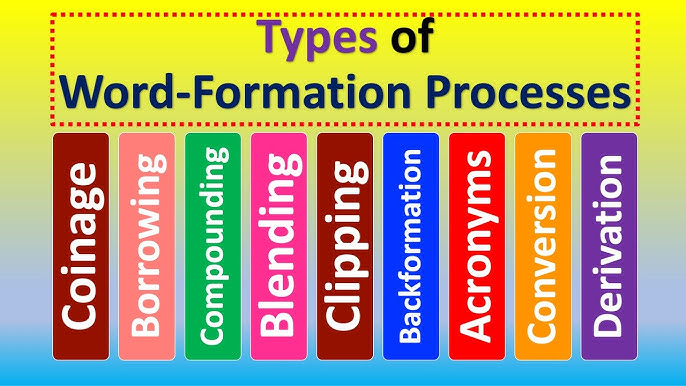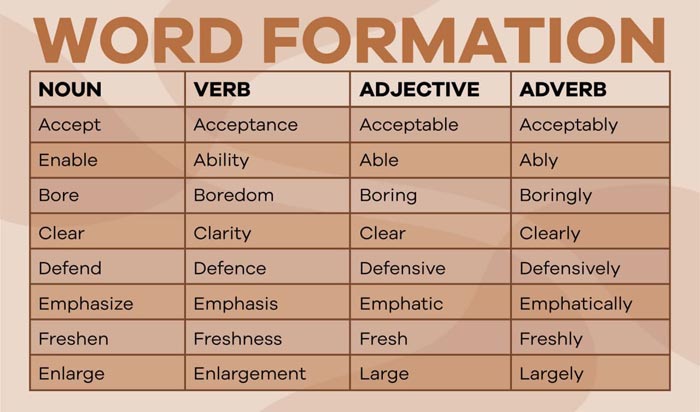IELTS Word formation: The process of increase your score
Word formation is a powerful tool that shapes the depth and diversity of a language’s lexicon. In the realm of language proficiency tests like the International English Language Testing System (IELTS), understanding the nuances of word formation becomes a strategic advantage. This essay explores the profound impact of word formation on one’s performance in the IELTS examination. From expanding vocabulary and refining grammatical accuracy to enhancing coherence and conveying complex ideas, we delve into how word formation can significantly influence success in this crucial language evaluation.

1. What is word formation?
Word formation, also known as morphology, refers to the process and rules by which new words are created in a language. It involves combining morphemes, which are the smallest units of meaning, to generate new words or modify the meaning and form of existing words. Morphemes can be individual words (free morphemes) or prefixes, suffixes, and roots (bound morphemes).
Understanding word formation is essential for building vocabulary, improving language skills, and effectively using and comprehending words in speech and writing. It helps language learners grasp the structure and development of words within a language, contributing to effective communication and linguistic proficiency.
>>See also: Grammar for IELTS
2. What are the type of word formation
Word formation involves various processes through which new words are created or existing words are modified to convey different meanings or grammatical functions. Here are the main types of word formation:
2.1. Affixation
Adding prefixes (before the root) or suffixes (after the root) to an existing word to create a new word with altered meaning or grammatical category.
Example:
Prefix: “un-” (e.g., unhappy, unlock)
Suffix: “-ly” (e.g., quickly, happily)
2.2. Compounding
Combining two or more complete words to form a new word with a distinct meaning.
Example:
“toothpaste” (tooth + paste)
“basketball” (basket + ball)
2.3. Conversion (Zero Derivation)
Changing the grammatical category or part of speech of a word without adding affixes.
Example:
Noun to verb: “text” (noun) to “text” (verb)
Adjective to noun: “green” (adjective) to “the green” (noun)
2.3. Blending
Combining parts of two or more words to form a new word with a combined meaning.
Example:
“brunch” (breakfast + lunch)
“smog” (smoke + fog)
2.4. Clipping (Shortening)
Creating a new word by shortening an existing word, often by removing one or more syllables.
Example:
“advertisement” to “ad”
“examination” to “exam”
2.5. Acronyms
Forming a new word from the initial letters of a phrase or series of words, usually pronounced as a single word.
Example:
“NASA” (National Aeronautics and Space Administration)
“laser” (Light Amplification by Stimulated Emission of Radiation)
2.6. Reduplication
Repeating all or part of a word to create a new word, often for emphasis or to indicate a related concept.
Example:
“chit-chat”
“pitter-patter”
2.7. Back-Formation
Creating a new word by removing a presumed affix from an existing word.
Example:
“donation” to “donate”
“editor” to “edit”
These word formation processes contribute to the richness and flexibility of a language, allowing for the creation of an extensive vocabulary and conveying a wide range of meanings and concepts.

3. What are word formation rules?
Creating words can be an intriguing linguistic endeavor, demanding careful consideration when incorporating inflections or affixes. Several factors should be taken into account during this process. Explore the ensuing pointers to gain deeper insights.
Before modifying the word’s stem, it’s essential to analyze the intended meaning and the word’s role within the sentence structure. Most often, the base word’s initial section remains unaltered. Only when prefixes are affixed does the word gain an extra syllable at the start. It’s noteworthy that, even in such cases, the original word remains unchanged.
When suffixes are introduced, numerous instances necessitate the removal of one or more letters from the end of the word before appending the suffix. However, exceptions like ‘movement’ demonstrate instances where the suffix can be added seamlessly without altering the base word’s spelling.
A practical method for determining the appropriate suffix to form a specific word class involves recognizing common patterns. Typically, nouns conclude with ‘er,’ ‘or,’ ‘ist,’ ‘ian,’ ‘ion,’ ‘ment,’ ‘ness,’ or ‘ity.’ Verbs often end in ‘ise,’ ‘ate,’ and ‘en,’ while adjectives terminate in ‘able,’ ‘ible,’ ‘ive,’ ‘ic,’ ‘ed,’ ‘ing,’ and ‘al.’ Adverbs, on the other hand, commonly conclude with ‘ly.’
Exercising caution is imperative when transforming words through conversion. Accurate conversion and precise sentence usage should be a priority.
During the formation of compound words, meticulous attention is necessary. Hyphenation should be employed judiciously when needed, ensuring an appropriate blend of words without haphazard juxtaposition.
Shifting between verb tenses is a noteworthy aspect of word formation, representing a subtle yet significant transformation. The inflection of the word provides essential cues about the different tenses in the English language.
The creation of degrees of comparison also falls within the realm of word formation. Comparative and superlative degrees can be achieved by adding ‘er’ and ‘est’ to adjectives. For polysyllabic words, the comparative and superlative degrees are formed using ‘more’ and ‘most,’ respectively, in conjunction with the adjective.
>> See also: Passie voice

4. How does word formation impact your IELTS exam?
Understanding word formation and effectively utilizing it can positively impact your IELTS exam performance, particularly in the IELTS Writing and IELTS Speaking sections. Here’s how:
4.1. Vocabulary Range and Lexical Resource (Writing, Speaking)
Word formation expands your vocabulary range and lexical resources, which are assessed in both the Writing and Speaking modules. Utilizing a variety of word forms and knowing how to form words correctly demonstrate your ability to convey your ideas precisely and appropriately.
4.2. Accuracy and Range of Grammar (Writing, Speaking)
Properly using affixes, prefixes, and suffixes in word formation showcases your grammatical accuracy. It reflects your understanding of grammatical rules and your ability to apply them effectively, contributing to higher scores in the IELTS exam.
4.3. Complex Sentence Structures (Writing, Speaking)
Word formation allows you to create complex sentence structures, enhancing the sophistication of your language. This complexity is crucial for achieving higher band scores, especially in the Writing module, where coherence and cohesion are vital.
4.4. Clarity and Precision of Expression (Writing, Speaking)
Choosing the right affixes and word forms based on context ensures that your message is clear and precise. Word formation helps you convey your thoughts in a manner that is easily comprehensible to the reader or listener, positively impacting your scores.
4.5. Task Achievement (Writing)
In the Writing Task 2 essay, employing appropriate word formation techniques enables you to address the essay prompt effectively, ensuring your response is on topic and relevant. It contributes to achieving the task’s objectives and meeting assessment criteria.
4.6. Formal and Academic Tone (Writing, Speaking)
Knowing how to use affixes and formality in word choices is crucial, particularly for achieving a formal and academic tone in both writing and speaking. It’s essential for essays, reports, and academic discussions in the IELTS exam.
4.7. Coherence and Cohesion (Writing, Speaking)
Using consistent and appropriate word forms through word formation contributes to the overall coherence and cohesion of your writing and speaking, enhancing the flow and structure of your responses.
4.8. Listening and Reading (Indirect Impact)
Understanding word formation aids in decoding unfamiliar words during the Listening and Reading sections, potentially improving your comprehension and performance in these areas.
Overall, a strong grasp of IELTS word formation enhances your language skills and supports your performance across all four components of the IELTS exam, contributing to a better chance of achieving your desired band score.
In conclusion, word formation stands as a cornerstone for achieving success in the IELTS test. Its impact transcends mere vocabulary expansion, reaching into the realms of grammar, coherence, and precision of expression. A rich understanding of word formation empowers individuals to navigate the intricacies of the English language, enabling them to communicate effectively and demonstrate their language proficiency at its best during the IELTS examination. Start your journey now by taking the IELTS online test!